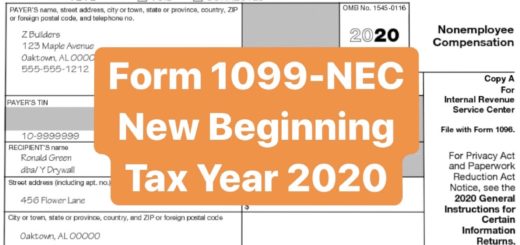Freelancer vs Employee: How do I classify my workers?
Table of Contents
This article provides an overview of worker classification about how to determine if your worker is an independent contractor vs employee.

It’s important for business owners to understand the proper classification of an independent contractor or freelancer vs employee. How do you know who is an employee or an independent contractor? The answer to this question has important ramifications on business taxes.
Please note at the bottom of this article are links to various resources provided by the IRS to help employers determine worker classification.
Worker classification determines whether or not a business is required to withhold:
- Income taxes
- Medicare taxes
- Unemployment taxes
- Pay Social Security on earnings paid to people that do work
One of the biggest triggers for an IRS audit is incorrectly classifying employees as independent contractors.
What is an employee?
A person who does work for you such that you control what will be done and how it will be done is considered an employee (under common law).
For example, Jane Smith is a customer service representative for a company, Acme, Inc. She works five days a week and is assigned to go to the office Monday through Friday from 9 am to 5 pm. While she is working she takes calls from customers and answers their questions. Also, she replies to customer service emails that arrive in the customer support inbox. She is paid a commission on any products or services she up-sells to existing customers. Acme, Inc. pays for her health insurance. All of this makes Jane an employee of Acme, Inc.
What is an independent contractor?
An individual is considered an independent contractor if they’re in control of how the work is done and what is done to deliver the work. What this means is the independent contractor determines what hours of the day they work, and what days of the week they work. In addition, independent contractors aren’t required to come to an office. Independent contractors come to the office when they want. The only control the employer has in this situation is the result of the work. Further, the earnings of an independent contractor are subject to Self-Employment tax.
Common job types where people are hired as independent contractors are dentists, veterinarians, lawyers, accountants, contractors, subcontractors, etc. Essentially, anyone who offers their services to the general public.
Still not sure; how to decide an employee vs non employee?
There are three categories of control to help you determine if your payee is an employee vs non-employee.
Behavioral Control
A worker is an employee when a business has the right to direct and control the worker’s work. This is known as behavioral control. Different categories of behavioral control are described below to clarify if a worker is an employee vs a non-employee.
- Type of instruction given. For example, the company specifies when and where to work. What tools to use or where to purchase supplies and services.
- Degree of instruction. More detailed instruction is indicative the worker is an employee. Whereas less instruction means less control and likely that the worker is an independent contractor.
- Evaluation systems. An evaluation system about ‘how’ the work is done indicates that the worker is an employee. However, an evaluation systems that measure the end result of the work could mean the worker is either an employee or an independent contractor.
- Worker training. When you train a worker about how to do a job this worker is likely and employee. Further, periodic or on-going worker training about procedures and methods means that the worker is an employee. Independent contractors are free to use their own procedures and methods in the course of doing their work.
Financial Control
Financial control has to do with the rights the business has in regard to the financial aspects of the worker’s job. The following things need to be considered:
- Investment in equipment. If a significant investment is made in equipment used by the worker to do a job for someone else.
- Expense reimbursement. Typically, employees are reimbursed for expenses and independent contractors are not.
- Profit of loss opportunity. Opportunity for profit or loss indicates that the work is an independent contractor.
- Services available to the market. Independent contractors are free to work for more than one payor at a time.
- Method of payment. Employees are typically on the payroll and paid a regular wage. Employees receive wages in regular paychecks biweekly, monthly or any other period of time. Sometimes they’re paid by the hour. In contrast, independent contractors are often paid a flat rate for a job.
Relationship
The type of relationship between a company and a worker often depends on how the worker and the business perceive their interaction with one another. This includes the following:
- Contracts. Written contracts that describe the relationship intended to create between the business and the worker. However, please note that a contract stating specifically that the worker is an employee or an independent contractor is not enough to establish the workers status. The other topics in this article need to be taken into consideration.
- Benefits. A worker provided benefits, such as health insurance, 401K, paid vacation day, paid sick days, etc., are employees. Independent contractors typically don’t get these benefits.
- Relationship duration expectation. A worker is typically classified as an employee if the working relationship is expected to continue indefinitely. On the other hand, the worker is classified as an independent contractor if the relationship is for a specific project or for only a specified amount of time.
- Services provided are key activity of the business. Typically and employee performs services that are regarded as key aspects of the business that employs them.
Read the following article for more details about the different types of employee benefits, which when provided make the worker needs to be classified as an employee: Employee Benefits that Mean Your Worker is an Employee.
What are the consequences of misclassifying an employee?
A business that incorrectly classifies an employee as an independent contractor is liable for employment taxes. Employers can use Form SS-8, Determination of Worker Status for Purposes of Federal Employment Taxes and Income Tax Withholding, to help them determine the status of their workers.
Additional IRS Resources
- Publication 15-A, Employer’s Supplemental Tax Guide
- Form 1040-ES, Estimated Tax for Individuals
- Publication 505, Tax Withholding and Estimated Tax
- Publication 535, Business Expenses
- For information on eligibility for a voluntary program to reclassify workers as employees with partial relief from federal employment taxes, visit Voluntary Classification Settlement Program (VCSP).
About Falcon Expenses
Falcon Expenses is a top-rated expense and mileage tracker app for self-employed and small businesses to track expenses and tax deductions. Falcon customers record $6,600, on average, in annual tax deductions. Get started today. The longer you wait, the more tax deductions you miss.
Automatically track mileage expenses and expenses, keep an odometer log, receipt vault and log billable hours. Quickly organize expenses by time period, project, or client. Easily create expense reports and mileage logs with your expense data to email to anyone in PDF or spreadsheet formats, all from your phone. Falcon’s expense report template is IRS compliant. Use for keeping track of tax deductions, reimbursements, taxes, record keeping, and more. Falcon Expenses is great for self-employed, freelancers, realtors, delivery drivers, couriers, business travelers, truckers, and more.
Was this article helpful?
We are a team of writers and contributors with a passion for creating valuable content for small business owners, self-employed, entrepreneurs, and more.
Feel free to reach out to use as support@falconexpenses.com





